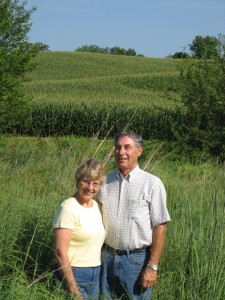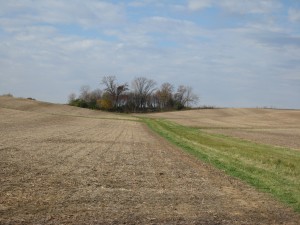
Illinois producers, Tom and Margaret Hitzhusen, have implemented a variety of conservation programs to help reduce erosion and make soil and water improvements on their 148-acre farm.
Tom and Margaret Hitzhusen knew they had their work cut out for them when 18 years ago they purchased a 148-acre farm near Geneseo, a picturesque rural community along I-80 20 miles east of Moline, Illinois.
“The land was in pretty poor condition and suffered significant amounts of erosion over the years,” said Tom Hitzhusen. “Some of the more visible problems were erosion of the stream banks and gullies.”
The Hitzhusens used the USDA Farm Service Agency (FSA) Conservation Reserve Program (CRP) to make soil and water improvements on their farm.
CRP, which is celebrating its 30th anniversary this year, is among the largest private lands program for conservation used to reduce soil erosion, improve water and air quality and provide wildlife habitat. CRP is a voluntary program that allows eligible landowners to receive annual rental payments and cost-share assistance to establish long-term, resource-conserving covers on eligible farmland throughout the duration of their 10-to-15-year contracts.
Improvements on the Hitzhusen’s CRP acres include four acres of grass waterways along with filter strips, shelterbelts and the establishment of permanently introduced grasses and legumes. Each of these programs has improved specific conservation concerns, but the Hitzhusens are especially impressed with their filter strips.
Planting only 66 feet of grass strips along both sides of the streams has effectively stopped bank erosion and gullying as well as helped filter nutrients and sediment runoff from the cropland.
“Only a small amount of acreage is required for the filter strips, but the payback is huge,” said Hitzhusen. “It is one of the most efficient and cost-effective conservation practices I have found.”

The Hitzhusens small commitment to conservation yielded huge results when 66 feet of CRP grass filter strips helped stop bank erosion and gulling and also assisted with filtering nutrient and sediment runoff from the cropland.
To further conservation efforts, the Hitzhusens added two grade stabilization structures in the creek to help stop creek bed erosion, which in turn, minimizes bank erosion.
“We used native grasses and forbs for permanent cover on our steeper ground which has slopes varying from 18 to 30 percent in grade,” said Hitzhusen. “The steepness of the slopes made the acres virtually impossible to farm.”
The Hitzhusens also follow a strict nutrient management regimen using precision farming tools, variable rate applicators, soil and tissue analysis and multiple applications during the growing season to ensure that all of the nutrients are used by the plant, limiting excess nutrients from going into ground water or drainage systems.
All crops on the farm are grown using no-till practices, including acres that are not considered highly erodible.
“Keeping the crop residue on the surface protects the soil, increases water infiltration, conserves moisture and builds organic matter content of the soil,” said Hitzhusen.
In addition to working with FSA, the Hitzhusens also partnered with USDA’s Natural Resources Conservation Service (NRCS) and the Soil and Water Conservation District (SWCD) to implement a total of 12 different conservation practices.
All of the Hitzhusen’s CRP practices are implemented on just 15.1 acres, which shows that a small commitment can have a large impact.
The Hitzhusens are very active in their community and have hosted numerous farm tours to showcase the different conservation practices used to enhance the environment of their farm.
Hard work did not go unnoticed when the Hitzhusens were named the 2013 Governor’s Conservation Farm Family of the Year, an award program organized by the Association of Illinois Soil and Water Conservation Districts.
Since being established on December 23, 1985, CRP has helped prevent more than 8 billion tons of soil from eroding and protected more than 170,000 stream miles with riparian and grass buffers, more than 100,000 acres of bottomland hardwood trees, nearly 300,000 acres of flood-plain wetlands, and 250,000 acres each for duck nesting habitat and upland bird habitat.
2015 marks the 30th Anniversary of CRP. For an interactive tour of CRP success stories from across the U.S., please visit the FSA CRP 30th Anniversary website at http://www.fsa.usda.gov/CRPis30.





